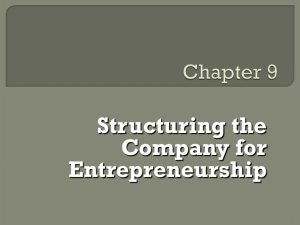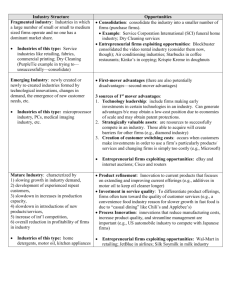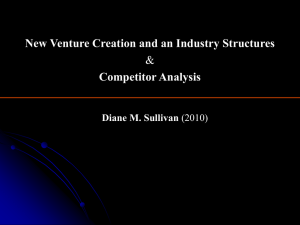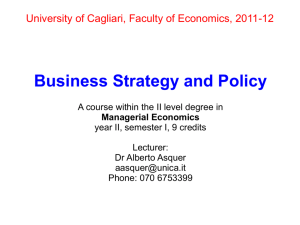Industry, Competitor, & Market Feasibility Day #2
advertisement
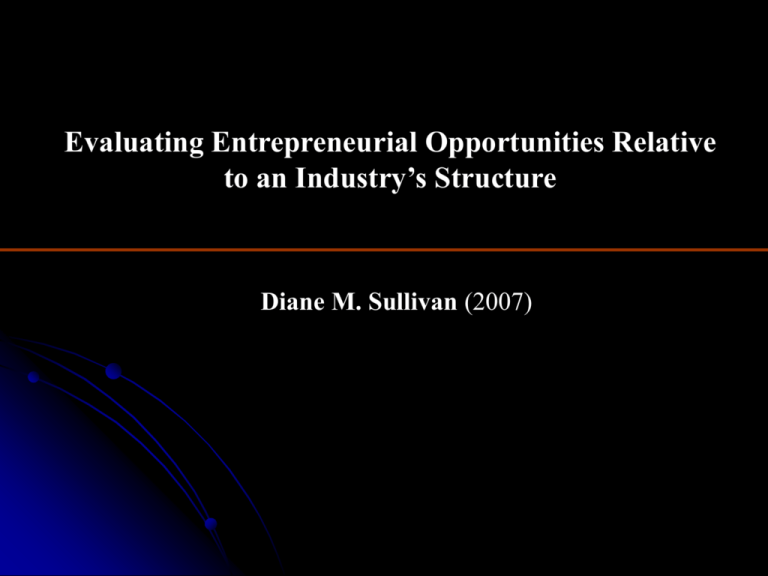
Evaluating Entrepreneurial Opportunities Relative to an Industry’s Structure Diane M. Sullivan (2007) Industry Structures An industry’s structure indicates the stage of an industry its life cycle Suggests types of firms that will likely be successful in the industry Helps us determine if the window of opportunity is open for new entrants Suggests strategic moves that new entrants or existing firms can take to capitalize on opportunities created as a result of industry characteristics 5 general structures an industry can take (these are not mutually exclusive): 1. Emerging 2. Fragmented 3. Mature 4. Declining 5. Global Industry Structures: Emerging Indicated by: Newly created or re-created industries Primary causes: technological innovations, changes in demand, the emergence of new customer needs, etc. Examples: microprocessors, digital music, cell phones, biotechnology Entrepreneurial opportunities present in emerging industries: Gain a first-mover advantages via: Technology leadership: can create the technology standard (e.g., Microsoft), gain lowcost position due to economies of scale (Wal-Mart), obtain patent protection Caution: second-mover advantages may occur where imitators can duplicate the first movers’ patents—research shows imitators can do this for 65% of the cost of the first-mover Strategically valuable assets (e.g., required resources to compete in industry): access to raw materials (e.g., mining industries), favorable geographic locations (Wal-Mart in medium-sized cities before competition), valuable product market positions (breakfast manufacturers; luxury vehicles) Create customer switching costs: create a cost for customers to change to another firm’s offerings (e.g., software, pharmaceuticals, even some grocery stores) Industry Structures: Fragmented Indicated by: A large number of small to SME firms in the industry No one has dominant market share No one creates a dominant technology Primary causes: few barriers to entry, no economies of scale, may need close local control over enterprises to ensure quality Examples: service industries like retailing, commercial printing, dry cleaning, local movie houses Entrepreneurial opportunities present in fragmented industries: Consolidation: firms can consolidate (e.g., purchase firms) the industry to move create a smaller number of larger firms Examples: Blockbuster consolidated the video rental industry Service Corporation International (SCI) in the funeral industry (found new economies of scale) Midas has consolidated muffler repair shops Industry Structures: Mature Indicated by: Slowing industry growth Development of repeat customers Slowing of production capacity Slowdown in new product/service introductions Increased international competition Overall reduction in profitability of firms in industry Primary causes: technology diffusion, reduction in innovation rate Examples: fast food; motor oil, large discount retailers; laundry detergents, kitchen appliances Entrepreneurial opportunities present in mature industries: Product refinement: focus on extending/improving current products and technologies (e.g., additives to motor oil, more concentrated laundry detergents; front-loading washing machines; Silk Soymilk) Investment in service quality: increase customer service quality (e.g., restaurant industry and the casual dining segment—Applebee's; Chili's—versus fast-food service) Process innovation: activities used to design, product and sell products/services (e.g., US automobile industry; Dell and supply-chain management in PC industry) Industry Structures: Declining Indicated by: An industry that has experienced an absolute decline in unit sales over a sustained period of time. Examples: Traditional video rental industry; US defense industry after the Cold War in the 1980s Entrepreneurial opportunities present in declining industries: Market Leadership: wait out shakeout period; facilitate shakeout by purchasing competitors’ product lines, then try to gain majority of market share (e.g., Martin Marietta in defense industry acquiring GE’s aerospace business—then merged with Lockheed to become Lockheed Martin) Market Niche: reduce scope of operations and focus on narrow segments in industry (e.g., Polaroid with instant photography) Harvest: long, systematic, phased withdrawal from industry while extracting as much value as possible Divestment: quickly withdraw from industry after industry decline pattern is established so no additional costs incurred (e.g., can sell product lines to competitors) Industry Structures: Global Indicated by: industry experiencing significant international sales Examples: athletic shoes; internet auctions; fast food Entrepreneurial opportunities present in global industries: Pursue Multidomestic Strategy: customize product/service offerings per each market’s specific needs/wants (fast food; eBay) Pursue Global Strategy: approach each market with the same offerings (e.g., Nike) Determine which strategy appropriate by similarity of consumers’ tastes across markets




